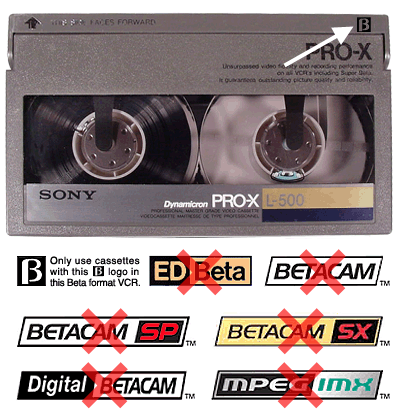|
Only cassettes that have this  symbol or mark can be used in a Beta VCR. There were other video cassettes that look like Beta but are recorded in different formats. They will go into this machine, but they will not play a recognizable picture. Cassette harmony is covered in this discussion. symbol or mark can be used in a Beta VCR. There were other video cassettes that look like Beta but are recorded in different formats. They will go into this machine, but they will not play a recognizable picture. Cassette harmony is covered in this discussion.
When Betamax first hit the scene there was only one cassette and it was for Betamax. But in later years that changed. The shell design was so good that it was used for a number of professional tape formats. These are NOT compatible with the Beta recording format. These cassette will go into the machine but their recordings WILL NOT play correctly. Because these other systems use the same cassette shell this can cause some confusion today. I want to clear away the mystery, so here is the lowdown on the various formats, other than Betamax, and why they will not work.  *Note: Betacam (not BetacamSP or the others) cassettes are loaded with a common oxide formula tape (only the recording method is different for this format, the tape is not). These can be used for recording and playback in regular Beta format VCRs. You will need to put tape over the protection hole to do this. Results show they record just as good as regular cassettes. You can also fool your machine into using the other cassettes (the ones with the big red X though them) if you want to try them. They are good but the downside is they are use a special high-density recording media and they are pricy. Regular Beta machines simply can't take advantage of their denser metal tape formula. The luminance signal of regular Beta just doesn't go high enough to benefit. One other thing. You can use these premium cassettes (the ones with the big red X though them) in the ED Beta units. BetacamSP, Digital Betacam, etc. will be recognized by the ED machine and the results are great. Confused yet? If you want to really delve into video tape and the different video formats check this out. In 2004 the state of Texas commissioned a Videotape Identification and Assessment guide. To examine it click here then run the pdf that opens. The actual address should the link not connect properly is: https://www.arts.texas.gov/wp-content/uploads/2012/04/video.pdf |